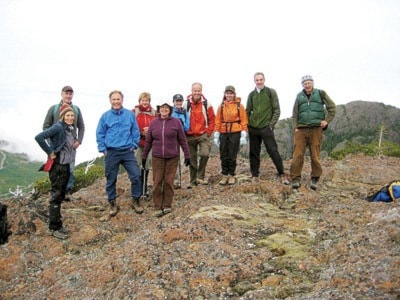We’ll have to wait an additional five years to find out how plant life on Mt. Arrowsmith is reacting to global warming, but the data collected by then will be far more valuable.
Kristina Swerhun, who spearheaded the GLORIA research project on Mt. Arrowsmith in 2006, said this week she had planned to update her research on vascular plants in the alpine area every five years, with her first update in 2011, but a dearth of funding means she has had to put off her first data update until 2016.
While unfortunate, she said, the delay means the data collected will be far more indicative of long-term trends when it finally is analyzed.
“We had hoped to do a full resurvey of the site to re-monitor the vegetation, but the funding didn’t come through this year,” Swerhun said. “However, because it’s such a long-term program and alpine plants grow so slowly, we weren’t sure it would show any changes yet.”
The project is part of a worldwide study called the Global Observation Research Initiative in Alpine environments, or GLORIA, with the aim of establishing a long-term observation network across the planet to monitor the reaction of alpine vegetation to global climate change, as well as temperature variations at higher elevations.
Although she won’t be conducting her followup analysis of the vascular plant life for another five years, Swerhun stressed the information collected to date won’t be wasted.
“We went up the mountain this year and replaced the temperature loggers because they can only hold five years of data,” she said. “The Whistler-Blackcomb Foundation and the Alpine Club of Canada provided a little funding to pay for the loggers, myself and the volunteers to go up there.”
A report released this month from European GLORIA monitors indicated the decade between 2000 and 2009, the warmest on record, showed indications of a progressive decline of cold mountain habitats and the species that rely on them.
Although she was unable to say whether this decline was being mirrored on Mt. Arrowsmith or its sister study area at Whistler, Swerhun said the findings came as no big surprise.
“I expected to find results similar to what they found in Europe, in that cold-adapted species will have their range shrinking and warm-adapted species will out-compete them and their range will spread,” she said.
Swerhun, who began the study while still a research assistant with the Department of Geography at the University of Victoria, has moved on to work with the Sea to Sky Invasive Species Council, said she’s keeping tabs on her GLORIA research as a hobby, but she stressed the work remains more relevant than ever.
“The United States is a little behind Europe in tis research and we are a little behind the United States,” she said. “However, with climate change, we need to know how it is affecting biodiversity and eventually, how that change in biodiversity affects system function. These are just the building blocks of what can be expected in the future. We need to know if there are any mitigation measures we can do, or if it is out of our hands.”
news@pqbnews.com
